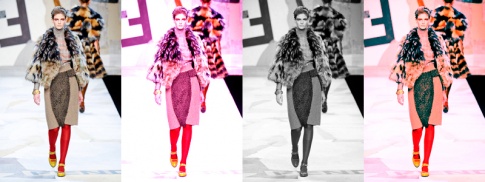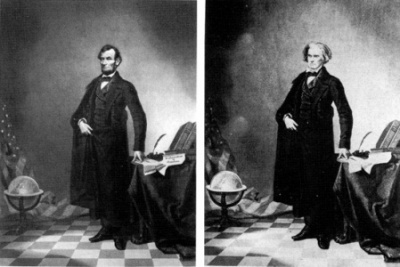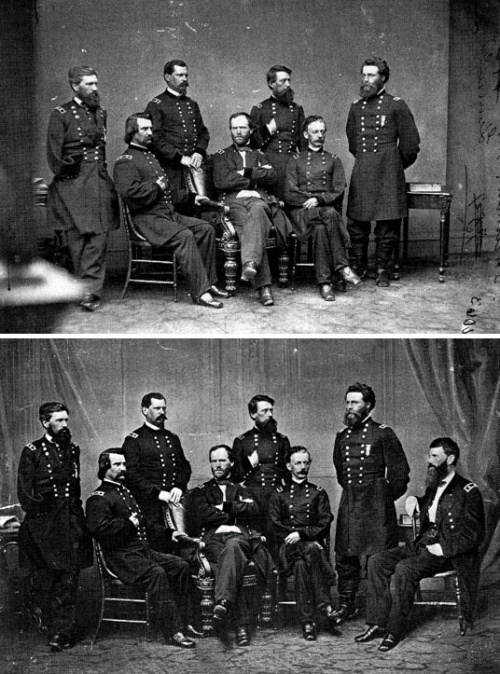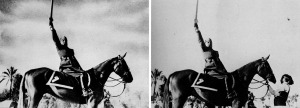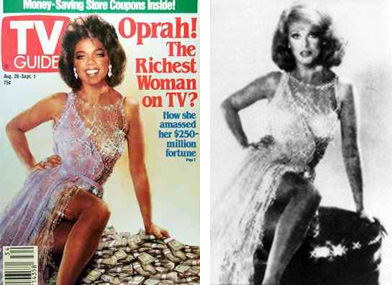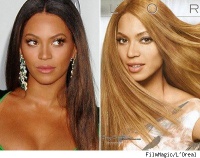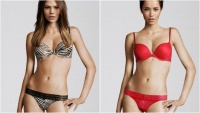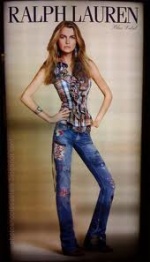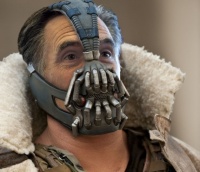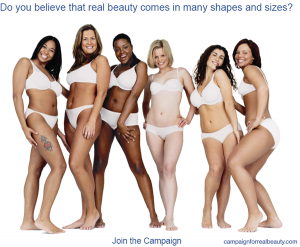Difference between revisions of "Photo Editing"
(→Public Response) |
|||
| (196 intermediate revisions by 44 users not shown) | |||
| Line 1: | Line 1: | ||
| − | + | {{nav-Bar|topics#P}}<br> | |
| − | ''' | + | [[File:Main_pic_editing.jpg|485px|thumb|right|top|The original photo is on the left with three edited versions to the right of the original.]] |
| + | '''{{initial|P}}hoto Editing''' is the alteration of an image through a computer software program or mobile application, or the automatic enhancement of an image by modern digital camera options. Artistic photo enhancement has increased in popularity as computer software built for pixel alteration has become more available and user-friendly. Due to the increasing difficulty in identifying the point at which a photo has been edited, ethical concerns have spawned from photo alteration, particularly when used as false evidence. With the ubiquity of photo enhancements, there has been an increased interest in [[Phototruth|truth in photography]]. The increasing quality of mobile photography has also introduced a wide range of photo editing apps which can apply color and lighting effects, change facial features, add the appearance of makeup, and delete objects in the background, among other effects. | ||
| − | == | + | ==Background== |
| + | The first photo editing was in 1860. A photo of American president [[Wikipedia:Abraham Lincoln|Abraham Lincoln]] was edited using body parts from others. Photo Editing continued in the 19th century when photographs were first put on glass and tin plates. These photos were altered using a variety of methods: ink, scratching, airbrushing. To edit negatives, one pieced photos together in the darkroom. Today, the term "photoshopping" is used as a metonym for photo editing, lending its name from the professional raster effects computer program, [[Wikipedia: Adobe Photoshop|Adobe Photoshop.]]<ref>[https://en.wikipedia.org/wiki/Photo_manipulation Wikipedia: Photo manipulation]</ref> | ||
| − | === | + | ==Examples== |
| − | + | ===Pre-Digital Era=== | |
| − | The first notable edited photo came in 1860, | + | Before the release of Photoshop, photos were usually edited through a physical process. This often involved cutting and pasting to fix elements in the photograph rather than digital manipulation of colors or shapes as the software allows today. <ref>Zhang, Michael. [https://petapixel.com/2013/05/08/how-photographers-photoshopped-their-pictures-back-in-1946/ How Photographers 'Photoshopped' Their Pictures Back in 1946.]PetaPixel, 8 May 2013. </ref> Since film photographs had to be developed through a physical process, the negatives could be combined to form composite images that were then printed onto paper. <ref>Uren, Amanda. [https://mashable.com/2015/02/19/before-photoshop/#MrA5ExmwgGqn "1850s-1950s Photoshop before Photoshop"] Mashable. 19 February 2015.</ref>. |
| + | ====First Edited Photo==== | ||
| + | The first notable edited photo came in 1860, shortly after Niepce invented the photograph. It was a composition of President Abraham Lincoln's head on the body of John Calhoun. | ||
[[file:Lincoln121.jpg|400px]] | [[file:Lincoln121.jpg|400px]] | ||
| − | === | + | ====Ulysses S. Grant Portrait==== |
| − | + | An 1864 photo depicts General Ulysses S. Grant during the American Civil War, but was created using three different photos combined together. | |
| − | + | ||
[[File:C1864-Grant.jpg|800px]] | [[File:C1864-Grant.jpg|800px]] | ||
| − | === | + | ====General Sherman==== |
| − | + | [[File:Historical-war-generals-edited-photo.jpg|500px|right]]In a photo of General Sherman in 1865 with all of his generals, one of the generals was subsequently added in at a later date. | |
| − | + | ||
| − | [[File:Historical-war-generals-edited-photo.jpg|500px]] | + | |
| − | + | ||
| − | + | ||
| − | In | + | |
| + | ====Benito Mussolini==== | ||
| + | In 1942, Benito Mussolini had his horse trainer removed from the picture in order to appear more heroic.<ref>[http://twistedsifter.com/2012/02/famously-doctored-photographs/ "Famously Doctored Photographs."] Retrieved on 11 Apr. 2018.</ref> | ||
[[File:Mussolini12.jpg]] | [[File:Mussolini12.jpg]] | ||
| − | === | + | ====Oprah==== |
| − | In 1989, Oprah's head was placed on a body from an advertisement for | + | In 1989, Oprah's head was placed on a body from an advertisement for a gown. This was done by physically cutting and pasting the images together. Neither the gown designer nor Oprah were notified about this before the ad went public.<ref>Garber, Megan. [http://www.theatlantic.com/technology/archive/2012/06/oprahs-head-ann-margarets-body-a-brief-history-of-pre-photoshop-fakery/258369/ “Oprah's Head, Ann-Margaret's Body: A Brief History of Pre-Photoshop Fakery.”] The Atlantic. 11 June 2012.</ref> |
[[File:Aug1989-Oprah.jpg]] | [[File:Aug1989-Oprah.jpg]] | ||
| − | == | + | ==Digital Photo Editing== |
| − | + | Digital photos are stored on computers in the form of a grid containing elements known as pixels. Each pixel contains a color specified by three numbers, a red green and blue value. Combining these three color values produces the color desired. Modern photo editing programs such as [https://www.adobe.com/products/photoshop.html Adobe Photoshop] or [https://www.paintshoppro.com/en/products/paintshop-pro/ultimate/ Corel's Paint Shop Pro] are programmed to allow the users to change the information of each pixel individually or in large clusters. | |
| − | + | ===Techniques=== | |
| + | ====Cropping==== | ||
| + | Cropping is used to show only a selection of the picture by deleting pixels and reducing the image size. It is primarily used to focus the attention of a viewer on a particular portion of the image or to remove unwanted subjects. Cropping can change the context of a scene or remove information from a photo. | ||
| − | == | + | ====Color Manipulation==== |
| − | + | Color manipulation can be applied to the entire image or selective parts. It can be used to increase or decrease saturation, hue, or brightness to achieve certain effects. In popular media, color manipulation has been used to alter skin tones and hair color to achieve an ad's desired effect, such as lighter or tanned skin and brighter, shinier hair. | |
| + | [[File:Beyonce-loreal-lightening-pic.jpg|200px|thumb|right| A cosmetic ad that lightened musical artist Beyonce's skin tone.]] | ||
| − | == | + | ====Liquify==== |
| + | The Liquify tool is a tool in Adobe Photoshop. It allows user to distort pixels without losing their quality. This filter allows users to push, pull, rotate, reflect, pucker, and bloat the pixels of any image. Changeable properties with the Liquify filter are Forward Warp, Reconstruct, Twirl, Pucker, Bloat, Push, Mirror, Turbulence, Freeze / Thaw Mask, Hand and Zoom. <ref>Guzman, Alvaro. [https://design.tutsplus.com/tutorials/a-comprehensive-guide-to-photoshops-liquify-tool--psd-8094 "A Comprehensive Guide to Photoshop's Liquify Tool"], 20 May 2010. Retrieved on 17 April 2017.</ref> | ||
| + | ====Noise Reduction==== | ||
| + | Noise Reduction can be applied in order to get rid of small particles and small details in an image. By using this technique, it allows the original picture to become cleaner and is a tool often used to remove minuscule unwanted pixels in an image. <ref> Wikipedia - Image Editing [https://en.wikipedia.org/wiki/Image_editing] </ref> | ||
| − | === | + | ===Software=== |
| − | + | ====Photoshop==== | |
| + | Photoshop is one of the components of Adobe's Creative Cloud. It offers many different features such as cropping, burning, and liquify. It is one of the more popular software options for more advanced users. Though it is not the most user friendly piece of software, Adobe's website offers many tutorials on how to perform certain actions on photos. | ||
| − | + | ====iPhoto==== | |
| + | iPhoto, found on Mac computers, is the storage spot for photographs on Mac computers. Users can upload their photos from the internet or from their storage device (SD card, cell phone, etc.), sort them into albums based on event, location, or faces, and perform simple edits. When uploading images from one's mobile devices, the software uses the geo-tag attached to the photo to sort the photo according to location. The software also has the ability to recognize faces and sorts photographs based on who appears in them as well. | ||
| − | + | On iPhoto, users can crop and rotate images. They can also adjust color schemes, add filters, and sharpen images. One limitation of the software is that one cannot add or remove features of a photo, which one can do with Photoshop and other paid or more advanced software. | |
| − | + | ||
| − | + | ==Photo Editing and Social Media== | |
| + | Photo editing has become more prevalent with the rise of social media and mobile photography. | ||
| − | + | ====Picnik==== | |
| + | [https://en.wikipedia.org/wiki/Picnik Picnik] is a web-based photo editing service that allowed users to perform edits such as cropping, straightening, contrast and saturation adjustments, among others. Users can add text boxes and illustrations to their photos from Picnik's library of fonts and illustrations. The service was shut down on April 19, 2013.<ref>Picnic [https://www.picnik.com/]</ref> | ||
| − | [[ | + | ====Instagram==== |
| + | The image-based social media platform [[Wikipedia:Instagram|Instagram]] popularized mobile versions of photo-editing. Instagram's native editing tools include cropping, straightening, adjusting brightness and contrast, and enhancing sharpening and removing red-eye. Instagram also popularized quick color effects for photos called filters. Third-party apps were developed for Instagram users to further edit photos. These include: Planoly, a mobile application used to plan out an Instagram feed, | ||
| − | + | ====VSCO==== | |
| + | [[Wikipedia:VSCO|VSCO]], "Visual Supply Company," is a mobile app that allows users to apply various color effects to their photos to evoke vintage film processing techniques for which their effects are named for. In addition, users have to ability to change the brightness, enhance certain features, color the photo, or make it look as if it was taken on a disposable camera. Users favor the filters that make their photos look older as younger generations are growing more interested in old "vintage" styles. | ||
| − | === | + | ====Facetune==== |
| − | + | [[Wikipedia:Facetune|Facetune]] is a mobile app that allows users to digitally retouch their photos using various tools, such as blur, liquify, and hue adjustments. The app is designed to edit "selfies" (self-portraits) with the ability to whiten teeth, remove blemishes, alter eye and hair color, and reduce wrinkles. In 2018, Facetune became the number-one paid application in the App Store. Given the success of the app, developers rolled out a second version of the app, Facetune 2, that offers different features like the ability to widen the eyes and smile, replace backgrounds, and tweak features while users take photos, not after. These features are offered in addition to the classic features offered on the original app. | |
| − | == | + | ====Afterlight==== |
| + | [https://en.wikipedia.org/wiki/Afterlight Afterlight] is a photo editing app that allows users to edit photographs through the use of advanced tools, overlays, artwork and text, and filters. Some of the advanced tools include curves, selective hue/saturation, clarify, and tone, allowing users to alter the shape and color of the photograph.<ref>Apple Store Website https://itunes.apple.com/us/app/afterlight-2/id1293122457?mt=8</ref> | ||
| − | + | ====BeautyPlus, BeautyCam, and SelfieCity==== | |
| − | [[File:Uwmadison12-1-tm.jpg| | + | BeautyPlus, BeautyCam, and SelfieCity are mobile apps that are owned by Meitu, Inc. Users can beautify their themselves using editing tools that smooth out their skin, enhance their features, and brighten their eyes. These apps are installed on more than one billion phones and are especially popular in China. Meitu's apps generate six billion photos per month, and more than half of the selfies posted in China are edited with a Meitu app. <ref> Fan, Jiayang. “China's Selfie Obsession.” The New Yorker, The New Yorker, 11 Dec. 2017, [https://www.newyorker.com/magazine/2017/12/18/chinas-selfie-obsession https://www.newyorker.com/magazine/2017/12/18/chinas-selfie-obsession] </ref> |
| + | |||
| + | ==Controversy and Backlash== | ||
| + | [[File:Uwmadison12-1-tm.jpg|200px|thumb|right|University of Wisconsin Madison modifies brochure image to promote diversity]] | ||
| + | [[File:Adnan_Hajj_Beirut_photo_comparison.jpg|180px|thumb|The original photo is featured on the left, and the edited photo is on the right.]] | ||
===University of Wisconsin at Madison=== | ===University of Wisconsin at Madison=== | ||
| − | [[Wikipedia:University of Wisconsin|University of Wisconsin]] at Madison wanted to portray student diversity in one its brochures by inserting an African-American student in | + | [[Wikipedia:University of Wisconsin|University of Wisconsin]] at Madison wanted to portray student diversity in one of its brochures by inserting an African-American student, Diallo Shabazz, in a crowd of white students. He was unaware that he was included in this photo until a counselor let him know. The photo was widely used and represented the falsely constructed sense of diversity created by college administrations. The original photograph (right) was taken in 1993 and the additional student in the photograph to the left was added from a picture taken in 1994. |
| − | + | ||
| − | + | ||
===Lebanon War Photographs=== | ===Lebanon War Photographs=== | ||
| − | In 2006, [[Wikipedia:Reuters|Reuters]], a news agency in New York, was caught publishing altered photos of the Lebanon War. Reuters fired photographer Adnan Hajj, who used a software editing program to manipulate many of his war photos. CAMERA, a pro-Israel media watch organization, said that the alleged photographic manipulations were used as propaganda by the mainstream media in an attempt to sway public opinion and paint Israel as an aggressor, suggesting that Israel was guilty of targeting civilians. <ref>http://www.camera.org/index.asp?x_context=2&x_outlet=2&x_article=1175</ref>A film released on [[Wikipedia:YouTube|YouTube]] compares the two images, pointing out the striking similarities between the photograph used by Reuters on both July 24 and August 5. <ref>http://www.youtube.com/watch?v=dJ5Rj4yBGdU</ref> | + | In 2006, [[Wikipedia:Reuters|Reuters]], a news agency in New York, was caught publishing altered photos of the Lebanon War. Reuters fired photographer Adnan Hajj, who used a software editing program to manipulate many of his war photos. CAMERA, a pro-Israel media watch organization, said that the alleged photographic manipulations were used as propaganda by the mainstream media in an attempt to sway public opinion and paint Israel as an aggressor, suggesting that Israel was guilty of targeting civilians. Manipulations included adding and darkening smoke to a building recently attacked and adding missiles to a picture of a fighter firing a flare.<ref>Hollander, Ricki. [http://www.camera.org/index.asp?x_context=2&x_outlet=2&x_article=1175 "Updated: A Reprise: Media Photo Manipulation."] 8 August 2006. Retrieved on 17 April 2017.</ref>A film released on [[Wikipedia:YouTube|YouTube]] compares the two images, pointing out the striking similarities between the photograph used by Reuters on both July 24 and August 5. <ref>x122mail. [http://www.youtube.com/watch?v=dJ5Rj4yBGdU "Reuters Faked Photos"], ''[[YouTube]]'', 6 August 2006. Retrieved on 17 April 2017.</ref> |
| + | [[File:microsoftps.jpg|200px|thumb|left|Microsoft edits image in Poland]] | ||
===2009 Microsoft Photograph === | ===2009 Microsoft Photograph === | ||
| − | In 2009, an image in a [[Wikipedia:Microsoft|Microsoft]] Corporation advertisement was edited to transform the face of a black man into the face of a white man. On the US Microsoft website, the photo features one asian, one black, and one white. | + | In 2009, an image in a [[Wikipedia:Microsoft|Microsoft]] Corporation advertisement was edited to transform the face of a black man into the face of a white man. On the US Microsoft website, the photo features one asian, one black, and one white person. On the Polish Microsoft website, the black man was replaced by a white man. This alteration in the photo triggered an enormous amount of discussion in the online community. Online bloggers and commentators wondered if the change was racially motivated or not.<ref>Heussner, Ki Mae. [http://abcnews.go.com/Technology/AheadoftheCurve/11-photo-editing-flubs-digitally-altered-photo-disasters/story?id=8780937 "11 Photo-Editing Flubs: Ralph Lauren Ad Sparks Controversy."] ABC News. 8 October 2009. Retrieved on 17 April 2017.</ref> Some people suggested that the Polish image was changed so that the man in the photo would resemble their own country's people more. |
| − | [[File:h_m.jpeg| | + | [[File:h_m.jpeg|200px|thumb|left|H&M's virtual models]] |
===H&M=== | ===H&M=== | ||
| − | [http://www.hm.com/us/ H&M], a popular clothing store <ref>http://www.huffingtonpost.com/2011/12/05/hm-fake-model-bodies_n_1129864.html#s520429</ref> | + | [http://www.hm.com/us/ H&M], a popular clothing store, has recently been under fire for their clothing ads. H&M places computer-generated bodies under real models' heads<ref>Krupnick, Ellie. [http://www.huffingtonpost.com/2011/12/05/hm-fake-model-bodies_n_1129864.html#s520429 "H&M Uses Fake Bodies with Real Heads for Models (PHOTOS)"]. The Huffington Post. 06 December 2011. Retrieved on 17 April 2017.</ref>. This head-body disconnect was noticed by a Norway company, [http://www.aftonbladet.se/nyheter/article14028743.ab], a site that identifies photos that have been edited. H&M has since admitted to using computer-image bodies and converging them with a model's head. They maintain that they used this questionable practice to steer their customers' attention away from the model and towards the articles of clothing.<ref> Pemberton, Becky. [http://www.thesun.co.uk/sol/homepage/news/3981561/HM-under-fire-for-using-completely-virtual-models.html "H&M under fire for using 'completely virtual' models"]. The Sun. 06 December 2011. Retrieved on 17 April 2017.</ref> |
| − | H&M recently issued a response, defending its decision to use digitally-generated bodies. They do not regret their decision, instead | + | H&M recently issued a response, defending its decision to use digitally-generated bodies. They do not regret their decision, instead they compare the using of virtual bodies to using mannequins in retail stores. <ref> Kindelan, Katie. [http://abcnews.go.com/blogs/entertainment/2011/12/clothing-giant-hm-defends-use-of-virtual-models/ "Clothing Giant H&M Defends 'Perfect' Virtual Models"]. ABC News. 06 December 2011. Retrieved on 17 April 2017.</ref> H&M also claims that they did this because they were not pleased with the models that auditioned to model H&M clothes for their various campaigns. <ref> Krupnick, Ellie. [https://www.huffingtonpost.com/2011/12/05/hm-fake-model-bodies_n_1129864.html "H&M Uses Fake Bodies With Real Heads For Models (PHOTOS)"]. Huffington Post. 06 December 2011. Retrieved on 04 April 2018.</ref> |
| + | |||
| + | ===Aerie Real=== | ||
| + | Four years ago, American Eagle's brand [https://www.ae.com/aerie/aerie/s-cms/4840006?cm=sUS-cUSD&navdetail=mega:cat6610030 Aerie] launched the #AerieReal campaign that pledges to not retouch models in underwear and bathing suit advertisements to get rid of cellulite, stretch marks and rolls <ref>[https://www.ae.com/featured-aeriereal/aerie/s-cms/6890055 "AerieReal Campaign"] Retrieved on 11 Apr. 2018.</ref>. In the latest edition of the campaign, Aerie brought 4 notable women to be the face of the campaign; Aly Raisman, Yara Shahidi, Rachel Platten, and Iskra Lawrence. The pictures of these women together show no sign of editing and demonstrate a natural, real body. <ref>Storm, Meg. [https://www.usmagazine.com/stylish/pictures/yara-shahidi-aly-raisman-more-star-in-unretouched-aerie-campaign/ "Yara Shahidi, Aly Raisman, Iskra Lawrence and Rachel Platten Star in Latest Unretouched #AerieREAL Campaign."] US Magazine. 26 January 2018. Retrieved on 11 Apr 2018.</ref> The attention this campaign has drawn pushed its effort from a product campaign to a movement focused on empowering women and promoting positive, realistic body standards <ref> Marsh, Ariana. [https://www.teenvogue.com/story/aerie-releases-new-unretouched-campaign "News Aerie Releases New Unretouched Campaign."] Teen Vogue. 25 January 2018. Retrieved on 11 Apr 2018</ref>. [[File:Ralphfillipa.jpg|150px|thumb|right|Ralph Lauren Model photoshopped]] | ||
===Ralph Lauren=== | ===Ralph Lauren=== | ||
| − | + | [[Wikipedia:Ralph Lauren|Ralph Lauren]] photoshoppers severely edited an image of model Filippa Hamilton. The public has severely criticized the company for its extreme use of digital manipulation on Hamilton, who is five-foot-ten and 120 pounds. This advertisement campaign sparked much controversy because it presents a distorted body image by medical standards. It gained a lot of media attention, particularly because Hamilton's waist was edited to be a smaller width than her head. Ralph Lauren's actions can have negative implications on women and young girls and their perception of their bodies and body images. They have since fired Hamilton for reportedly being too fat <ref>[http://www.huffingtonpost.com/2009/10/14/filippa-hamilton-ralph-la_n_320396.html "Filippa Hamilton, Ralph Lauren's Retouched Model: I Was Fired For Being Too Fat (VIDEO)"], The Huffington Post. 18 March 2010. Retrieved on 17 April 2017.</ref>. | |
| − | [[Wikipedia:Ralph Lauren|Ralph Lauren]] photoshoppers edited | + | [[File:O-BANE-CAPITAL-ROMNEY-570.jpg|200px|thumb|left| "It doesn't matter who we are... what matters is our plan. No one cared who I was until I put on the mask."]] |
| − | + | ||
| − | + | ||
| − | + | ||
| − | + | ||
| − | + | ||
| − | + | ||
| − | + | ||
| − | + | ||
| − | + | ||
| − | + | ||
| − | + | ||
| − | + | ||
| − | + | ||
| − | + | ||
| − | + | ||
| − | + | ||
===Tina Fey=== | ===Tina Fey=== | ||
| + | American comedian Tina Fey has advocated for a middle of the road approach to Photoshop, writing in her memoir "Bossypants:"''Fey believes that the usage of Photoshop reflects society's high beauty standards but it can be used if needed. <ref>[http://www.goodreads.com/quotes/show/370374 "Quote by Tina Fey: "I feel about Photoshp the way some people feel about..."] Goodreads. 12 Apr 2017.</ref>'' Fey also cites several magazines as having a sensible approach to photo manipulation such as Bust Magazine using photo editing to enhance the lighting. She contrasts this approach with her InStyle cover in which part of her torso was removed to make her appear slimmer<ref>Littlejohn, Georgina. [http://www.google.com/url?sa=t&rct=j&q=&esrc=s&source=web&cd=1&ved=0CCAQFjAA&url=http%3A%2F%2Fwww.dailymail.co.uk%2Ftvshowbiz%2Farticle-1367528%2FPhotoshop-mishap-Tina-Fey-comedy-actress-gets-chop-US-InStyle-cover.html&ei=4n7tTqDVH-r40gGzoOXgCg&usg=AFQjCNG8fkJZut3V6yogWhfVYzDxDkonew&sig2=vrsK7Q2emXskWZyWWeE2KA "Photoshop mishap for Tina Fey..."] Daily Mail. 18 March 2011. Retrieved on 12 April 2017</ref>. | ||
| − | + | ===British Legislatures=== | |
| + | After a beauty ad featuring wrinkle-free Twiggy, British legislators voiced their desire to ban the use of Photoshop for advertisements whose target audiences were under 16 years of age. Jo Swinson, then-member of the British parliament, commented on the harmful effects unrealistic beauty standards can have on young girls and that banning airbrushing in advertising would lessen the beauty related pressures many girls feel. <ref>North, Anna. [http://jezebel.com/5328736/british-lawmakers-take-stand-against-photoshop "British Lawmakers Take Stand Against Photoshop."] Jezebel. 3 Aug 2011. Retrieved on Apr 12 2017. </ref> | ||
| − | '' | + | ===Domino's Pizza=== |
| + | Domino's has started a Totally Real Talk Campaign, that exposes the process of what pizzas have to go through before getting photographed for promotional materials. Some companies have staged their photos with nails, blowtorches, or steam guns on their pizzas before shooting. Dominos has announced that they are only going to be photographing pizzas that come straight from their ovens, with no staging or altering. <ref>Johnston, Maura. [http://www.theawl.com/2010/07/dominos-taking-brave-stand-in-the-war-against-photoshop "Domino’s Taking Brave Stand In The War Against Photoshop."] The Awl. 7 July 2010. Retrieved on 12 April 2017. </ref> | ||
| − | + | === No retouching ad campaigns === | |
| + | In 2004, [[Wikipedia:Dove|Dove]] launched a marketing campaign titled Dove Campaign for Real Beauty. The purpose of the campaign was to help build self-esteem for women to be comfortable with themselves and to celebrate the female body no matter the shape or size. Dove released a [http://www.youtube.com/watch?v=hibyAJOSW8U commercial] showcasing the power of photo editing and stating ''"No wonder our perception of beauty is distorted"'' in the video. | ||
| − | + | [[File:reald.png|thumb|An underwear ad as part of the campaign remarked as being photo edited.]] | |
| − | + | Some of the pictures that were included in the campaign were argued to be edited. A spokesperson from Dove responded to these claims by admitting that some small correcting and adjustments were made to the women but that it didn't create an unrealistic or unattainable view of beauty.<ref>[http://www.businessweek.com/the_thread/brandnewday/archives/2008/05/an_experts_anal.html "An Experts Anal..."]</ref> Dove eventually elected to end their campaign due to a sharp decrease in sales growth. <ref>Morel, Lindsey, "The Effectiveness of the Dove Campaign for Real Beauty in Terms of Society and the Brand" (2009). Syracuse University Honors Program Capstone Projects. 480.</ref> The backlash reflected the consumer attitudes towards manipulation, suggesting that there is a strong desire for highly exaggerated depictions simply due to the fact that they represent what is considered beautiful. | |
| − | + | While the general public has been accepting of Dove's "Real Beauty" campaign, feminist sites and groups have exclaimed backlash. Many groups see Dove as not promoting "real" beauty but instead a socially scripted version of beauty. Some criticize Dove for a contradiction: putting more curvaceous, authentic looking models on their advertisements and yet producing a product that "firms" body parts. Jennifer L. Pozner from WIMN (Women in Media & News) wrote about how Dove's products perpetuate the stigma of aging as the products emphasize the effects of wrinkles and stretch marks aging has on the body, which Dove's products seeks to prevent. Richard Roeper, a columnist for the Chicago Sun Times, had a controversial response to the plus-size women in Dove's "Real Beauty" campaign, claiming that these kinds of women should not be featured in advertisments.<ref>Pozner, Jennifer L. [http://www.wimnonline.org/articles/dovebacklash.html "Dove's "Real Beauty" Backlash."] Women in Media & News. Retrieved on 11 Apr 2018.</ref> | |
| − | + | ||
| − | === | + | ===Glamour Magazine=== |
| − | + | In a recent past issue, Glamour Magazine ran an un-retouched photo of model Lizze Miller. At a size 12-14, Miller sits photographed nude and showcases her curves. Lizzie was from San Jose and came to New York to become a plus-size model. She struggled with her body image as a child but she mentions that as she got older, she realized that it did not matter to her and began to carry herself with confidence. | |
| − | + | The response has been huge and extremely positive. Women who saw Miller's photos appreciated the untouched, natural picture of a body they could relate to. Magazines rarely show women's physical imperfections of stretch marks and real body size. Lizzie mentions to Glamour that she flipped through pages to find a model that represented her the right way and only found confidence in herself when famous celebrities such as Beyonce and Jennifer Lopez were empowering women with curves. It is unclear whether Glamour Magazine will continue to include photos like these, but this photo continues to receive enthusiastic responses.<ref> Leive, Cindi. [http://www.glamour.com/health-fitness/blogs/vitamin-g/2009/08/on-the-cl-the-picture-you-cant.html "On the C.L.: The Picture You Can't Stop Talking About: Meet "the Woman on p. 194""] Glamour. 17 August 2009.</ref> | |
| − | + | ==Ethical Implications== | |
| − | [ | + | ===Misinformation=== |
| − | + | Although photo editing may be used to restore distorted or corrupted images, it can also be used to falsify information. Photo editing is often undetectable, making an altered image potentially deceiving to viewers, as visual memory is believed to be easier to recall than auditory memory. <ref>Blumberg, Joseph. [http://www.unisci.com/stories/20013/0726014.htm "Visual Memory Stronger Than Current Theory Has It." UniSci. 26 July 2001. 12 April 12 2017. ]</ref> Smith and Watson explain how one's representation of themselves or others can distort the authenticity of their actual self-representation.<ref> Smith, Sidonje. Watson, Julie. [https://quod.lib.umich.edu/m/maize/mpub9739969/1:12/--life-writing-in-the-long-run-a-smith-watson-autobiography?rgn=div1;view=fulltext "Authenticity in a virtual environment."] Retrieved on 11 Apr 2018.</ref> Through Photoshop methods, users have the ability to alter their images online thus changing their digital identity that is shown to the world. Photoshop techniques allow one to conform to idealized standards of what they should look like to society, and could hinder the originality and authenticity of one's true identity. | |
| + | ===Propaganda=== | ||
| + | Because photo manipulation can alter the truth of an image, it is a popular method to spread propaganda. Photo editing can provide misleading or biased information to promote a particular political cause or point of view. Cropping, removing or adding subjects, and enhancing features in a photograph are some of the ways a photo could be used to falsify information and influence the masses. Sometimes, photographs do even need to be photoshopped to be disputed. After President Trump's inaguration, the photo taken by Reuters of the inauguration crowd that showed gaps in the crowd at the back, was claimed as "alternative facts" by a White House aid <ref>Frisk, Adam. “Here's Why the Picture of Donald Trump's Inauguration Did Not Undersell Crowd Size.” Global News, 24 Jan. 2017, [https://globalnews.ca/news/3199200/donald-trump-inauguration-alternative-facts-photos-crowd-size/ https://globalnews.ca/news/3199200/donald-trump-inauguration-alternative-facts-photos-crowd-size/]. </ref>. In retaliation to comments comparing the size of the crowd to that of former president Obama's inauguration, former Press Secretary Sean Spicer pointed to the increased availability of streaming devices that allowed "tens of millions" of people to watch online.<ref>Trotta, Daniel. “Crowd Controversy: The Making of an Inauguration Day Photo.” Reuters, Thomson Reuters, 24 Jan. 2017, [https://www.reuters.com/article/us-usa-trump-inauguration-image/crowd-controversy-the-making-of-an-inauguration-day-photo-idUSKBN1572VU https://www.reuters.com/article/us-usa-trump-inauguration-image/crowd-controversy-the-making-of-an-inauguration-day-photo-idUSKBN1572VU]. </ref> | ||
| − | + | ===Body Dysmorphia=== | |
| + | Public figures are often photoshopped in published media, such as magazines and ad campaigns. A majority of women's magazines enhance the appearance of models, including alteration of skin tone, waistline, breast size, and teeth whiteness. According to the theory of social comparison, it is common for viewers of this content, especially younger women in their teens and twenties, to compare themselves to edited photos of celebrities and models, which has been linked to decreased self-esteem and perception of body image. Currently, 7 million women in the United States suffer from eating disorders and 50% of girls between the ages of 11 and 13 believe they are overweight.<ref>[http://www.state.sc.us/dmh/anorexia/statistics.htm "Eating Disorder Statistics."] South Carolina Department of Psychological Health. 12 April 2017. </ref> Even in cases where an individual is aware that a photo has been edited, photo editing can produce harmful effects. In 2011, the American Medical Association released a statement against Photoshop of bodies in advertising, stating that unrealistic body images continuously created and shown by the media contribute to eating disorders and other child and adolescent health problems."<ref> Carmon, Irin. [https://jezebel.com/5814439/magazines-adopt-policy-against-photoshop-in-advertising "American Medical Association Adopts Policy Against Photoshop In Advertising."] Jezebel. 22 June 2011. Retrieved on 11 Apr. 2018.</ref> | ||
| − | + | In a recent study, 33% of the women thought their ideal body was not achievable. When realizing the detrimental effects these applications have on women’s body image, it is time to consider what role technology plays in this.<ref>Vagianos, Alanna.[https://www.huffingtonpost.com/2013/11/27/photoshop-survey-women_n_4350263.html "Survey proves we still really need to talk about Photoshop."] Huffington Post. 27 November 2013. Retrieved on 11 April 2018.</ref> The capability of the program to perform body changes perpetuates the stigma that body’s are imperfect and should be altered to fit standards. The continuous use of these programs instill values of perfection, manifesting in body image issues and ultimately serious problems such as eating disorders, bullying, and even suicide. Since celebrities have used these programs to enhance their image for such a long time, the norm is to not promote one's natural figure. While there are many other features on the programs, we have chosen to use it for body alteration to fit the norm. | |
| − | === | + | ===Race=== |
| − | + | Another ethical implication of altering one's image through photoshopping methods is imposing an aspirational image of one's self. When someone alters their skin tone, hair color, body shape those changes signify how they want to perceive themselves. These changes can be harmful as users have the option to be seen as someone they are not. When posting these images on social media or using them in commercial advertisements, users are showing others an image of themselves that they would like others to see them as. This imposes ethical implications because an aspirational self-image can be a misrepresentation of someone true self and how they want others to see them. Many times magazines alter the color of the skin of a darker-skinned woman, so they can be seen as "whiter", conforming to the Euro-centric beauty ideal that lighter skin is better skin. <ref>Booth, Jessica. [http://www.gurl.com/2015/02/06/times-magazines-accused-of-photoshopping-lightening-celebrity-skin-white-washing/#1 10 Times Magazines were accused of using photo editing to make skin lighter.] 6 Feb. 2015</ref>. Celebrities such as [[Wikipedia:Kerry Washington|Kerry Washington]], [[Wikipedia:Lupita Nyong'o|Lupita Nyong'o]], and [[Wikipedia:Aishwarya Rai|Aishwarya Rai]] have had their cover photos for magazines such as Marie Claire, InStyle, and Vogue white washed the skin color of these women, making their skin multiple shades lighter than it actually is. | |
| − | + | In the journal Psychology of Women Quarterly, a researcher commented that the research showed spending more time reading magazines and on Facebook is associated with greater self-objectification among young women. This behavior and mentality affects relationships between women because the behavior of comparing their appearance to others is reinforced. At the University of New South Wales, a survey was done with 150 women aged 17-25. They found that these women spend an average of two hours a day on Facebook, checking the sites every few hours. They then found that Facebook users compare their own images to those of their peers rather than images of family members. These self-comparisons are detrimental as women see themselves as an observer and start to post fewer photos of themselves on Facebook as they feel insecure. <ref> Nauert, Rick. [https://psychcentral.com/news/2015/04/20/young-women-compare-themselves-on-social-media/83713.html 20 April 2015. "Young Women Compare Themselves on Social Media."] Retrieved 14 April 2017. </ref> | |
| − | + | ===Identity=== | |
| − | + | Photo editing tools are used to present an altered version of one's identity online. Social media platforms act as a stage for users to present the best versions of themselves to their followers. Users edit photos to their liking and only post specific experiences they want to share with their followers. By not exposing the whole truth about themselves, users do not accurately represent their online identities. Users are developing their own "online" and "offline" identities. <ref> “Chapter 5 - Informational Friction.” The 4th Revolution, by Luciano Floridi, Oxford University Press, 2014. </ref> | |
| − | === | + | |
| − | + | ||
| − | + | ||
| − | + | ||
| − | <ref> | + | |
| − | + | ||
| − | + | ||
| − | + | ||
==External Links== | ==External Links== | ||
| Line 153: | Line 153: | ||
*[http://listverse.com/2007/10/19/top-15-manipulated-photographs/ Top 15 Manipulated Photographs] | *[http://listverse.com/2007/10/19/top-15-manipulated-photographs/ Top 15 Manipulated Photographs] | ||
| − | + | ==References== | |
| + | <references/> | ||
| + | |||
| + | [[Category: Media Content]] | ||
| + | [[Category:GoldStar]] | ||
([[Topics|back to index]]) | ([[Topics|back to index]]) | ||
Latest revision as of 14:22, 25 April 2018
Contents
Background
The first photo editing was in 1860. A photo of American president Abraham Lincoln was edited using body parts from others. Photo Editing continued in the 19th century when photographs were first put on glass and tin plates. These photos were altered using a variety of methods: ink, scratching, airbrushing. To edit negatives, one pieced photos together in the darkroom. Today, the term "photoshopping" is used as a metonym for photo editing, lending its name from the professional raster effects computer program, Adobe Photoshop.[1]
Examples
Pre-Digital Era
Before the release of Photoshop, photos were usually edited through a physical process. This often involved cutting and pasting to fix elements in the photograph rather than digital manipulation of colors or shapes as the software allows today. [2] Since film photographs had to be developed through a physical process, the negatives could be combined to form composite images that were then printed onto paper. [3].
First Edited Photo
The first notable edited photo came in 1860, shortly after Niepce invented the photograph. It was a composition of President Abraham Lincoln's head on the body of John Calhoun.
Ulysses S. Grant Portrait
An 1864 photo depicts General Ulysses S. Grant during the American Civil War, but was created using three different photos combined together.
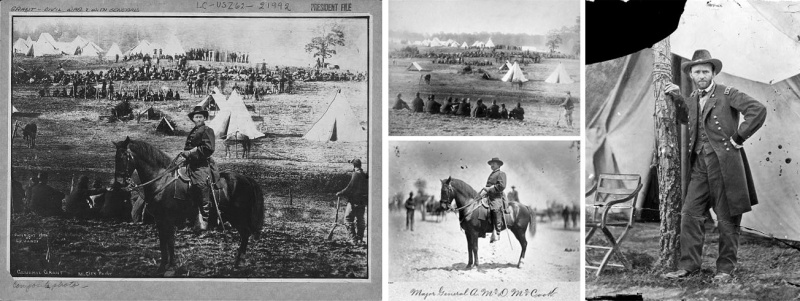
General Sherman
In a photo of General Sherman in 1865 with all of his generals, one of the generals was subsequently added in at a later date.Benito Mussolini
In 1942, Benito Mussolini had his horse trainer removed from the picture in order to appear more heroic.[4]
Oprah
In 1989, Oprah's head was placed on a body from an advertisement for a gown. This was done by physically cutting and pasting the images together. Neither the gown designer nor Oprah were notified about this before the ad went public.[5]
Digital Photo Editing
Digital photos are stored on computers in the form of a grid containing elements known as pixels. Each pixel contains a color specified by three numbers, a red green and blue value. Combining these three color values produces the color desired. Modern photo editing programs such as Adobe Photoshop or Corel's Paint Shop Pro are programmed to allow the users to change the information of each pixel individually or in large clusters.
Techniques
Cropping
Cropping is used to show only a selection of the picture by deleting pixels and reducing the image size. It is primarily used to focus the attention of a viewer on a particular portion of the image or to remove unwanted subjects. Cropping can change the context of a scene or remove information from a photo.
Color Manipulation
Color manipulation can be applied to the entire image or selective parts. It can be used to increase or decrease saturation, hue, or brightness to achieve certain effects. In popular media, color manipulation has been used to alter skin tones and hair color to achieve an ad's desired effect, such as lighter or tanned skin and brighter, shinier hair.
Liquify
The Liquify tool is a tool in Adobe Photoshop. It allows user to distort pixels without losing their quality. This filter allows users to push, pull, rotate, reflect, pucker, and bloat the pixels of any image. Changeable properties with the Liquify filter are Forward Warp, Reconstruct, Twirl, Pucker, Bloat, Push, Mirror, Turbulence, Freeze / Thaw Mask, Hand and Zoom. [6]
Noise Reduction
Noise Reduction can be applied in order to get rid of small particles and small details in an image. By using this technique, it allows the original picture to become cleaner and is a tool often used to remove minuscule unwanted pixels in an image. [7]
Software
Photoshop
Photoshop is one of the components of Adobe's Creative Cloud. It offers many different features such as cropping, burning, and liquify. It is one of the more popular software options for more advanced users. Though it is not the most user friendly piece of software, Adobe's website offers many tutorials on how to perform certain actions on photos.
iPhoto
iPhoto, found on Mac computers, is the storage spot for photographs on Mac computers. Users can upload their photos from the internet or from their storage device (SD card, cell phone, etc.), sort them into albums based on event, location, or faces, and perform simple edits. When uploading images from one's mobile devices, the software uses the geo-tag attached to the photo to sort the photo according to location. The software also has the ability to recognize faces and sorts photographs based on who appears in them as well.
On iPhoto, users can crop and rotate images. They can also adjust color schemes, add filters, and sharpen images. One limitation of the software is that one cannot add or remove features of a photo, which one can do with Photoshop and other paid or more advanced software.
Photo Editing and Social Media
Photo editing has become more prevalent with the rise of social media and mobile photography.
Picnik
Picnik is a web-based photo editing service that allowed users to perform edits such as cropping, straightening, contrast and saturation adjustments, among others. Users can add text boxes and illustrations to their photos from Picnik's library of fonts and illustrations. The service was shut down on April 19, 2013.[8]
The image-based social media platform Instagram popularized mobile versions of photo-editing. Instagram's native editing tools include cropping, straightening, adjusting brightness and contrast, and enhancing sharpening and removing red-eye. Instagram also popularized quick color effects for photos called filters. Third-party apps were developed for Instagram users to further edit photos. These include: Planoly, a mobile application used to plan out an Instagram feed,
VSCO
VSCO, "Visual Supply Company," is a mobile app that allows users to apply various color effects to their photos to evoke vintage film processing techniques for which their effects are named for. In addition, users have to ability to change the brightness, enhance certain features, color the photo, or make it look as if it was taken on a disposable camera. Users favor the filters that make their photos look older as younger generations are growing more interested in old "vintage" styles.
Facetune
Facetune is a mobile app that allows users to digitally retouch their photos using various tools, such as blur, liquify, and hue adjustments. The app is designed to edit "selfies" (self-portraits) with the ability to whiten teeth, remove blemishes, alter eye and hair color, and reduce wrinkles. In 2018, Facetune became the number-one paid application in the App Store. Given the success of the app, developers rolled out a second version of the app, Facetune 2, that offers different features like the ability to widen the eyes and smile, replace backgrounds, and tweak features while users take photos, not after. These features are offered in addition to the classic features offered on the original app.
Afterlight
Afterlight is a photo editing app that allows users to edit photographs through the use of advanced tools, overlays, artwork and text, and filters. Some of the advanced tools include curves, selective hue/saturation, clarify, and tone, allowing users to alter the shape and color of the photograph.[9]
BeautyPlus, BeautyCam, and SelfieCity
BeautyPlus, BeautyCam, and SelfieCity are mobile apps that are owned by Meitu, Inc. Users can beautify their themselves using editing tools that smooth out their skin, enhance their features, and brighten their eyes. These apps are installed on more than one billion phones and are especially popular in China. Meitu's apps generate six billion photos per month, and more than half of the selfies posted in China are edited with a Meitu app. [10]
Controversy and Backlash
University of Wisconsin at Madison
University of Wisconsin at Madison wanted to portray student diversity in one of its brochures by inserting an African-American student, Diallo Shabazz, in a crowd of white students. He was unaware that he was included in this photo until a counselor let him know. The photo was widely used and represented the falsely constructed sense of diversity created by college administrations. The original photograph (right) was taken in 1993 and the additional student in the photograph to the left was added from a picture taken in 1994.
Lebanon War Photographs
In 2006, Reuters, a news agency in New York, was caught publishing altered photos of the Lebanon War. Reuters fired photographer Adnan Hajj, who used a software editing program to manipulate many of his war photos. CAMERA, a pro-Israel media watch organization, said that the alleged photographic manipulations were used as propaganda by the mainstream media in an attempt to sway public opinion and paint Israel as an aggressor, suggesting that Israel was guilty of targeting civilians. Manipulations included adding and darkening smoke to a building recently attacked and adding missiles to a picture of a fighter firing a flare.[11]A film released on YouTube compares the two images, pointing out the striking similarities between the photograph used by Reuters on both July 24 and August 5. [12]
2009 Microsoft Photograph
In 2009, an image in a Microsoft Corporation advertisement was edited to transform the face of a black man into the face of a white man. On the US Microsoft website, the photo features one asian, one black, and one white person. On the Polish Microsoft website, the black man was replaced by a white man. This alteration in the photo triggered an enormous amount of discussion in the online community. Online bloggers and commentators wondered if the change was racially motivated or not.[13] Some people suggested that the Polish image was changed so that the man in the photo would resemble their own country's people more.
H&M
H&M, a popular clothing store, has recently been under fire for their clothing ads. H&M places computer-generated bodies under real models' heads[14]. This head-body disconnect was noticed by a Norway company, [3], a site that identifies photos that have been edited. H&M has since admitted to using computer-image bodies and converging them with a model's head. They maintain that they used this questionable practice to steer their customers' attention away from the model and towards the articles of clothing.[15]
H&M recently issued a response, defending its decision to use digitally-generated bodies. They do not regret their decision, instead they compare the using of virtual bodies to using mannequins in retail stores. [16] H&M also claims that they did this because they were not pleased with the models that auditioned to model H&M clothes for their various campaigns. [17]
Aerie Real
Four years ago, American Eagle's brand Aerie launched the #AerieReal campaign that pledges to not retouch models in underwear and bathing suit advertisements to get rid of cellulite, stretch marks and rolls [18]. In the latest edition of the campaign, Aerie brought 4 notable women to be the face of the campaign; Aly Raisman, Yara Shahidi, Rachel Platten, and Iskra Lawrence. The pictures of these women together show no sign of editing and demonstrate a natural, real body. [19] The attention this campaign has drawn pushed its effort from a product campaign to a movement focused on empowering women and promoting positive, realistic body standards [20].Ralph Lauren
Ralph Lauren photoshoppers severely edited an image of model Filippa Hamilton. The public has severely criticized the company for its extreme use of digital manipulation on Hamilton, who is five-foot-ten and 120 pounds. This advertisement campaign sparked much controversy because it presents a distorted body image by medical standards. It gained a lot of media attention, particularly because Hamilton's waist was edited to be a smaller width than her head. Ralph Lauren's actions can have negative implications on women and young girls and their perception of their bodies and body images. They have since fired Hamilton for reportedly being too fat [21].
Tina Fey
American comedian Tina Fey has advocated for a middle of the road approach to Photoshop, writing in her memoir "Bossypants:"Fey believes that the usage of Photoshop reflects society's high beauty standards but it can be used if needed. [22] Fey also cites several magazines as having a sensible approach to photo manipulation such as Bust Magazine using photo editing to enhance the lighting. She contrasts this approach with her InStyle cover in which part of her torso was removed to make her appear slimmer[23].
British Legislatures
After a beauty ad featuring wrinkle-free Twiggy, British legislators voiced their desire to ban the use of Photoshop for advertisements whose target audiences were under 16 years of age. Jo Swinson, then-member of the British parliament, commented on the harmful effects unrealistic beauty standards can have on young girls and that banning airbrushing in advertising would lessen the beauty related pressures many girls feel. [24]
Domino's Pizza
Domino's has started a Totally Real Talk Campaign, that exposes the process of what pizzas have to go through before getting photographed for promotional materials. Some companies have staged their photos with nails, blowtorches, or steam guns on their pizzas before shooting. Dominos has announced that they are only going to be photographing pizzas that come straight from their ovens, with no staging or altering. [25]
No retouching ad campaigns
In 2004, Dove launched a marketing campaign titled Dove Campaign for Real Beauty. The purpose of the campaign was to help build self-esteem for women to be comfortable with themselves and to celebrate the female body no matter the shape or size. Dove released a commercial showcasing the power of photo editing and stating "No wonder our perception of beauty is distorted" in the video.
Some of the pictures that were included in the campaign were argued to be edited. A spokesperson from Dove responded to these claims by admitting that some small correcting and adjustments were made to the women but that it didn't create an unrealistic or unattainable view of beauty.[26] Dove eventually elected to end their campaign due to a sharp decrease in sales growth. [27] The backlash reflected the consumer attitudes towards manipulation, suggesting that there is a strong desire for highly exaggerated depictions simply due to the fact that they represent what is considered beautiful.
While the general public has been accepting of Dove's "Real Beauty" campaign, feminist sites and groups have exclaimed backlash. Many groups see Dove as not promoting "real" beauty but instead a socially scripted version of beauty. Some criticize Dove for a contradiction: putting more curvaceous, authentic looking models on their advertisements and yet producing a product that "firms" body parts. Jennifer L. Pozner from WIMN (Women in Media & News) wrote about how Dove's products perpetuate the stigma of aging as the products emphasize the effects of wrinkles and stretch marks aging has on the body, which Dove's products seeks to prevent. Richard Roeper, a columnist for the Chicago Sun Times, had a controversial response to the plus-size women in Dove's "Real Beauty" campaign, claiming that these kinds of women should not be featured in advertisments.[28]
Glamour Magazine
In a recent past issue, Glamour Magazine ran an un-retouched photo of model Lizze Miller. At a size 12-14, Miller sits photographed nude and showcases her curves. Lizzie was from San Jose and came to New York to become a plus-size model. She struggled with her body image as a child but she mentions that as she got older, she realized that it did not matter to her and began to carry herself with confidence.
The response has been huge and extremely positive. Women who saw Miller's photos appreciated the untouched, natural picture of a body they could relate to. Magazines rarely show women's physical imperfections of stretch marks and real body size. Lizzie mentions to Glamour that she flipped through pages to find a model that represented her the right way and only found confidence in herself when famous celebrities such as Beyonce and Jennifer Lopez were empowering women with curves. It is unclear whether Glamour Magazine will continue to include photos like these, but this photo continues to receive enthusiastic responses.[29]
Ethical Implications
Misinformation
Although photo editing may be used to restore distorted or corrupted images, it can also be used to falsify information. Photo editing is often undetectable, making an altered image potentially deceiving to viewers, as visual memory is believed to be easier to recall than auditory memory. [30] Smith and Watson explain how one's representation of themselves or others can distort the authenticity of their actual self-representation.[31] Through Photoshop methods, users have the ability to alter their images online thus changing their digital identity that is shown to the world. Photoshop techniques allow one to conform to idealized standards of what they should look like to society, and could hinder the originality and authenticity of one's true identity.
Propaganda
Because photo manipulation can alter the truth of an image, it is a popular method to spread propaganda. Photo editing can provide misleading or biased information to promote a particular political cause or point of view. Cropping, removing or adding subjects, and enhancing features in a photograph are some of the ways a photo could be used to falsify information and influence the masses. Sometimes, photographs do even need to be photoshopped to be disputed. After President Trump's inaguration, the photo taken by Reuters of the inauguration crowd that showed gaps in the crowd at the back, was claimed as "alternative facts" by a White House aid [32]. In retaliation to comments comparing the size of the crowd to that of former president Obama's inauguration, former Press Secretary Sean Spicer pointed to the increased availability of streaming devices that allowed "tens of millions" of people to watch online.[33]
Body Dysmorphia
Public figures are often photoshopped in published media, such as magazines and ad campaigns. A majority of women's magazines enhance the appearance of models, including alteration of skin tone, waistline, breast size, and teeth whiteness. According to the theory of social comparison, it is common for viewers of this content, especially younger women in their teens and twenties, to compare themselves to edited photos of celebrities and models, which has been linked to decreased self-esteem and perception of body image. Currently, 7 million women in the United States suffer from eating disorders and 50% of girls between the ages of 11 and 13 believe they are overweight.[34] Even in cases where an individual is aware that a photo has been edited, photo editing can produce harmful effects. In 2011, the American Medical Association released a statement against Photoshop of bodies in advertising, stating that unrealistic body images continuously created and shown by the media contribute to eating disorders and other child and adolescent health problems."[35]
In a recent study, 33% of the women thought their ideal body was not achievable. When realizing the detrimental effects these applications have on women’s body image, it is time to consider what role technology plays in this.[36] The capability of the program to perform body changes perpetuates the stigma that body’s are imperfect and should be altered to fit standards. The continuous use of these programs instill values of perfection, manifesting in body image issues and ultimately serious problems such as eating disorders, bullying, and even suicide. Since celebrities have used these programs to enhance their image for such a long time, the norm is to not promote one's natural figure. While there are many other features on the programs, we have chosen to use it for body alteration to fit the norm.
Race
Another ethical implication of altering one's image through photoshopping methods is imposing an aspirational image of one's self. When someone alters their skin tone, hair color, body shape those changes signify how they want to perceive themselves. These changes can be harmful as users have the option to be seen as someone they are not. When posting these images on social media or using them in commercial advertisements, users are showing others an image of themselves that they would like others to see them as. This imposes ethical implications because an aspirational self-image can be a misrepresentation of someone true self and how they want others to see them. Many times magazines alter the color of the skin of a darker-skinned woman, so they can be seen as "whiter", conforming to the Euro-centric beauty ideal that lighter skin is better skin. [37]. Celebrities such as Kerry Washington, Lupita Nyong'o, and Aishwarya Rai have had their cover photos for magazines such as Marie Claire, InStyle, and Vogue white washed the skin color of these women, making their skin multiple shades lighter than it actually is.
In the journal Psychology of Women Quarterly, a researcher commented that the research showed spending more time reading magazines and on Facebook is associated with greater self-objectification among young women. This behavior and mentality affects relationships between women because the behavior of comparing their appearance to others is reinforced. At the University of New South Wales, a survey was done with 150 women aged 17-25. They found that these women spend an average of two hours a day on Facebook, checking the sites every few hours. They then found that Facebook users compare their own images to those of their peers rather than images of family members. These self-comparisons are detrimental as women see themselves as an observer and start to post fewer photos of themselves on Facebook as they feel insecure. [38]
Identity
Photo editing tools are used to present an altered version of one's identity online. Social media platforms act as a stage for users to present the best versions of themselves to their followers. Users edit photos to their liking and only post specific experiences they want to share with their followers. By not exposing the whole truth about themselves, users do not accurately represent their online identities. Users are developing their own "online" and "offline" identities. [39]
External Links
- Photo Forensics Software
- Before Photoshop: 7 Photo Edits That Literally Made History
- L'Oréal Lightens Beyoncé Up Again
- Top 15 Manipulated Photographs
References
- ↑ Wikipedia: Photo manipulation
- ↑ Zhang, Michael. How Photographers 'Photoshopped' Their Pictures Back in 1946.PetaPixel, 8 May 2013.
- ↑ Uren, Amanda. "1850s-1950s Photoshop before Photoshop" Mashable. 19 February 2015.
- ↑ "Famously Doctored Photographs." Retrieved on 11 Apr. 2018.
- ↑ Garber, Megan. “Oprah's Head, Ann-Margaret's Body: A Brief History of Pre-Photoshop Fakery.” The Atlantic. 11 June 2012.
- ↑ Guzman, Alvaro. "A Comprehensive Guide to Photoshop's Liquify Tool", 20 May 2010. Retrieved on 17 April 2017.
- ↑ Wikipedia - Image Editing [1]
- ↑ Picnic [2]
- ↑ Apple Store Website https://itunes.apple.com/us/app/afterlight-2/id1293122457?mt=8
- ↑ Fan, Jiayang. “China's Selfie Obsession.” The New Yorker, The New Yorker, 11 Dec. 2017, https://www.newyorker.com/magazine/2017/12/18/chinas-selfie-obsession
- ↑ Hollander, Ricki. "Updated: A Reprise: Media Photo Manipulation." 8 August 2006. Retrieved on 17 April 2017.
- ↑ x122mail. "Reuters Faked Photos", YouTube, 6 August 2006. Retrieved on 17 April 2017.
- ↑ Heussner, Ki Mae. "11 Photo-Editing Flubs: Ralph Lauren Ad Sparks Controversy." ABC News. 8 October 2009. Retrieved on 17 April 2017.
- ↑ Krupnick, Ellie. "H&M Uses Fake Bodies with Real Heads for Models (PHOTOS)". The Huffington Post. 06 December 2011. Retrieved on 17 April 2017.
- ↑ Pemberton, Becky. "H&M under fire for using 'completely virtual' models". The Sun. 06 December 2011. Retrieved on 17 April 2017.
- ↑ Kindelan, Katie. "Clothing Giant H&M Defends 'Perfect' Virtual Models". ABC News. 06 December 2011. Retrieved on 17 April 2017.
- ↑ Krupnick, Ellie. "H&M Uses Fake Bodies With Real Heads For Models (PHOTOS)". Huffington Post. 06 December 2011. Retrieved on 04 April 2018.
- ↑ "AerieReal Campaign" Retrieved on 11 Apr. 2018.
- ↑ Storm, Meg. "Yara Shahidi, Aly Raisman, Iskra Lawrence and Rachel Platten Star in Latest Unretouched #AerieREAL Campaign." US Magazine. 26 January 2018. Retrieved on 11 Apr 2018.
- ↑ Marsh, Ariana. "News Aerie Releases New Unretouched Campaign." Teen Vogue. 25 January 2018. Retrieved on 11 Apr 2018
- ↑ "Filippa Hamilton, Ralph Lauren's Retouched Model: I Was Fired For Being Too Fat (VIDEO)", The Huffington Post. 18 March 2010. Retrieved on 17 April 2017.
- ↑ "Quote by Tina Fey: "I feel about Photoshp the way some people feel about..." Goodreads. 12 Apr 2017.
- ↑ Littlejohn, Georgina. "Photoshop mishap for Tina Fey..." Daily Mail. 18 March 2011. Retrieved on 12 April 2017
- ↑ North, Anna. "British Lawmakers Take Stand Against Photoshop." Jezebel. 3 Aug 2011. Retrieved on Apr 12 2017.
- ↑ Johnston, Maura. "Domino’s Taking Brave Stand In The War Against Photoshop." The Awl. 7 July 2010. Retrieved on 12 April 2017.
- ↑ "An Experts Anal..."
- ↑ Morel, Lindsey, "The Effectiveness of the Dove Campaign for Real Beauty in Terms of Society and the Brand" (2009). Syracuse University Honors Program Capstone Projects. 480.
- ↑ Pozner, Jennifer L. "Dove's "Real Beauty" Backlash." Women in Media & News. Retrieved on 11 Apr 2018.
- ↑ Leive, Cindi. "On the C.L.: The Picture You Can't Stop Talking About: Meet "the Woman on p. 194"" Glamour. 17 August 2009.
- ↑ Blumberg, Joseph. "Visual Memory Stronger Than Current Theory Has It." UniSci. 26 July 2001. 12 April 12 2017.
- ↑ Smith, Sidonje. Watson, Julie. "Authenticity in a virtual environment." Retrieved on 11 Apr 2018.
- ↑ Frisk, Adam. “Here's Why the Picture of Donald Trump's Inauguration Did Not Undersell Crowd Size.” Global News, 24 Jan. 2017, https://globalnews.ca/news/3199200/donald-trump-inauguration-alternative-facts-photos-crowd-size/.
- ↑ Trotta, Daniel. “Crowd Controversy: The Making of an Inauguration Day Photo.” Reuters, Thomson Reuters, 24 Jan. 2017, https://www.reuters.com/article/us-usa-trump-inauguration-image/crowd-controversy-the-making-of-an-inauguration-day-photo-idUSKBN1572VU.
- ↑ "Eating Disorder Statistics." South Carolina Department of Psychological Health. 12 April 2017.
- ↑ Carmon, Irin. "American Medical Association Adopts Policy Against Photoshop In Advertising." Jezebel. 22 June 2011. Retrieved on 11 Apr. 2018.
- ↑ Vagianos, Alanna."Survey proves we still really need to talk about Photoshop." Huffington Post. 27 November 2013. Retrieved on 11 April 2018.
- ↑ Booth, Jessica. 10 Times Magazines were accused of using photo editing to make skin lighter. 6 Feb. 2015
- ↑ Nauert, Rick. 20 April 2015. "Young Women Compare Themselves on Social Media." Retrieved 14 April 2017.
- ↑ “Chapter 5 - Informational Friction.” The 4th Revolution, by Luciano Floridi, Oxford University Press, 2014.
